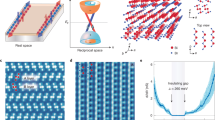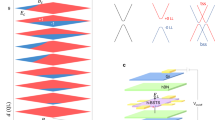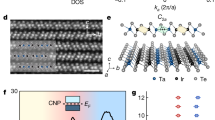Abstract
Quantum spin Hall insulators are two-dimensional materials that host conducting helical electron states strictly confined to the one-dimensional boundaries. These edge channels are protected by time-reversal symmetry against single-particle backscattering, opening new avenues for spin-based electronics and computation. However, the effect of the interelectronic Coulomb repulsion also has to be taken into account, as two-particle scattering is not impeded by topological protection and may strongly affect the edge state conductance. Here, we explore the impact of electronic correlations on highly localized edge states of the unique quantum spin Hall material bismuthene on SiC(0001) (ref. 1). Exploiting the advantage of having an accessible monolayer substrate system, we use STM/STS to visualize the close-to-perfect one-dimensional confinement of the edge channels and scrutinize their suppressed density of states at the Fermi level. On the basis of the observed spectral behaviour and its universal scaling with energy and temperature, we demonstrate the correspondence with a (helical) Tomonaga–Luttinger liquid. In particular, the extracted interaction parameter K is directly relevant to the fundamental question of the temperatures at which the quantized conductance (a hallmark of quantum spin Hall materials) will become obscured by correlations2.
This is a preview of subscription content, access via your institution
Access options
Access Nature and 54 other Nature Portfolio journals
Get Nature+, our best-value online-access subscription
$29.99 / 30 days
cancel any time
Subscribe to this journal
Receive 12 print issues and online access
$209.00 per year
only $17.42 per issue
Buy this article
- Purchase on Springer Link
- Instant access to full article PDF
Prices may be subject to local taxes which are calculated during checkout




Similar content being viewed by others
Data availability
The data that support the plots within this paper and other findings of this study are available from the corresponding author on reasonable request.
References
Reis, F. et al. Bismuthene on a SiC substrate: a candidate for a high-temperature quantum spin Hall material. Science 357, 287–290 (2017).
Li, T. et al. Observation of a helical Luttinger liquid in InAs/GaSb quantum spin Hall edges. Phys. Rev. Lett. 115, 136804 (2015).
Kane, C. L. & Mele, E. J. Quantum spin Hall effect in graphene. Phys. Rev. Lett. 95, 226801 (2005).
Kane, C. L. & Mele, E. J. Z 2 topological order and the quantum spin Hall effect. Phys. Rev. Lett. 95, 146802 (2005).
König, M. et al. Quantum spin Hall insulator state in HgTe quantum wells. Science 318, 766–770 (2007).
Knez, I., Du, R.-R. & Sullivan, G. Evidence for helical edge modes in inverted InAs/GaSb quantum wells. Phys. Rev. Lett. 107, 136603 (2011).
Wu, S. et al. Observation of the quantum spin Hall effect up to 100 Kelvin in a monolayer crystal. Science 359, 76–79 (2018).
Tang, S. et al. Quantum spin Hall state in monolayer 1T′-WTe2. Nat. Phys. 13, 683–687 (2017).
Wu, C., Bernevig, B. A. & Zhang, S.-C. Helical liquid and the edge of quantum spin Hall systems. Phys. Rev. Lett. 96, 106401 (2006).
Xu, C. & Moore, J. E. Stability of the quantum spin Hall effect: effects of interactions, disorder, and ℤ2 topology. Phys. Rev. B 73, 045322 (2006).
Li, G. et al. Theoretical paradigm for the quantum spin Hall effect at high temperatures. Phys. Rev. B 98, 165146 (2018).
Meyer, Chr, Klijn, J., Morgenstern, M. & Wiesendanger, R. Direct measurement of the local density of states of a disordered one-dimensional conductor. Phys. Rev. Lett. 91, 076803 (2003).
Pauly, C. et al. Subnanometre-wide electron channels protected by topology. Nat. Phys. 11, 338–343 (2015).
Voit, J. Charge–spin separation and the spectral properties of Luttinger liquids. Phys. Rev. B 47, 6740–6743 (1993).
Haldane, F. D. M. ‘Luttinger liquid theory’ of one-dimensional quantum fluids. I. properties of the Luttinger model and their extension to the general 1D interacting spinless Fermi gas. J. Phys. C. Solid State 14, 2585–2609 (1981).
Jompol, Y. et al. Probing spin–charge separation in a Tomonaga–Luttinger liquid. Science 325, 597–601 (2009).
Bockrath, M. et al. Luttinger-liquid behaviour in carbon nanotubes. Nature 397, 598–601 (1999).
Aleshin, A. N., Lee, H. J., Park, Y. W. & Akagi, K. One-dimensional transport in polymer nanofibers. Phys. Rev. Lett. 93, 196601 (2004).
Blumenstein, C. et al. Atomically controlled quantum chains hosting a Tomonaga–Luttinger liquid. Nat. Phys. 7, 776–780 (2011).
Chang, A. M., Pfeiffer, L. N. & West, K. W. Observation of chiral Luttinger behavior in electron tunneling into fractional quantum Hall edges. Phys. Rev. Lett. 77, 2538–2541 (1996).
Hohenadler, M. & Assaad, F. F. Luttinger liquid physics and spin-flip scattering on helical edges. Phys. Rev. B 85, 081106 (2012).
Braunecker, B., Bena, C. & Simon, P. Spectral properties of Luttinger liquids: a comparative analysis of regular, helical, and spiral Luttinger liquids. Phys. Rev. B 85, 035136 (2012).
Eggert, S. Scanning tunneling microscopy of a Luttinger liquid. Phys. Rev. Lett. 84, 4413–4416 (2000).
Fisher, M. P. A. & Dorsey, A. T. Dissipative quantum tunneling in a biased double-well system at finite temperatures. Phys. Rev. Lett. 54, 2647–2647 (1985).
Bartosch, L. & Kopietz, P. Zero bias anomaly in the density of states of low-dimensional metals. Eur. Phys. J. B 28, 29–36 (2002).
Hanna, A. E. & Tinkham, M. Variation of the Coulomb staircase in a two-junction system by fractional electron charge. Phys. Rev. B 44, 5919–5922 (1991).
Devoret, M. H. et al. Effect of the electromagnetic environment on the Coulomb blockade in ultrasmall tunnel junctions. Phys. Rev. Lett. 64, 1824–1827 (1990).
Ming, F., Smith, T. S., Johnston, S., Snijders, P. C. & Weitering, H. H. Zero-bias anomaly in nanoscale hole-doped mott insulators on a triangular silicon surface. Phys. Rev. B 97, 075403 (2018).
Väyrynen, J. I., Geissler, F. & Glazman, L. I. Magnetic moments in a helical edge can make weak correlations seem strong. Phys. Rev. B 93, 241301 (2016).
Teo, J. C. Y. & Kane, C. L. Critical behavior of a point contact in a quantum spin Hall insulator. Phys. Rev. B 79, 235321 (2009).
Acknowledgements
We thank B. Trauzettel, M. Bode, A. Kowalewski and J. Maciejko for useful discussions. This work was supported by the DFG through the Würzburg-Dresden Cluster of Excellence on Complexity and Topology in Quantum Matter (EXC 2147, project 39085490), the Collaborative Research Center SFB 1170 ‘ToCoTronics’ in Würzburg and the SPP 1666 Priority Programme ‘Topological Insulators’. We are also grateful for support from the ERC through starting grant ERC-StG-Thomale-336012 ‘Topolectrics’.
Author information
Authors and Affiliations
Contributions
R.S. and F.R. carried out the measurements. R.S. analysed the data and made the figures. T.M., T.H., T.S and R.T. developed the theory for the helical edge with dielectric screening. J.S. conceived the experiment. R.S., F.R., J.S. and R.C. wrote the text, and all authors contributed to critical discussion of the data.
Corresponding author
Ethics declarations
Competing interests
The authors declare no competing interests.
Additional information
Peer review information Nature Physics thanks Ward Plummer and the other, anonymous, reviewer(s) for their contribution to the peer review of this work.
Publisher’s note Springer Nature remains neutral with regard to jurisdictional claims in published maps and institutional affiliations.
Supplementary information
Supplementary Information
Supplementary Figs. 1–9, text and reference.
Supplementary Video
Continuous evolution of the DOS with energy and constant dI/dV scale.
Source data
Source data for Fig. 1c
Contains source data for Figure 1c.
Source data for Fig. 1d, left panel
Contains source data for Figure 1d left panel.
Source data for Fig. 1d, right panel
Contains source data for Figure 1d right panel.
Source data for Fig. 1d, right, Fourier filtered
Contains source data for Figure 1d right panel Fourier filtered.
Source data for Fig. 2a
Contains source data for Figure 2a.
Source data for Fig. 3a
Contains source data for Figure 3a.
Source data for Fig. 3b
Contains source data for Figure 3b.
Source data for Fig. 3c
Contains source data for Figure 3c.
Source data for Fig. 4
Contains source data for Figure 4.
Rights and permissions
About this article
Cite this article
Stühler, R., Reis, F., Müller, T. et al. Tomonaga–Luttinger liquid in the edge channels of a quantum spin Hall insulator. Nat. Phys. 16, 47–51 (2020). https://doi.org/10.1038/s41567-019-0697-z
Received:
Accepted:
Published:
Issue Date:
DOI: https://doi.org/10.1038/s41567-019-0697-z
This article is cited by
-
A robust and tunable Luttinger liquid in correlated edge of transition-metal second-order topological insulator Ta2Pd3Te5
Nature Communications (2023)
-
Tuning the many-body interactions in a helical Luttinger liquid
Nature Communications (2022)
-
Visualization of edge-modulated charge-density-wave orders in monolayer transition-metal-dichalcogenide metal
Communications Physics (2022)
-
Imaging gate-tunable Tomonaga–Luttinger liquids in 1H-MoSe2 mirror twin boundaries
Nature Materials (2022)
-
One-dimensional Luttinger liquids in a two-dimensional moiré lattice
Nature (2022)



